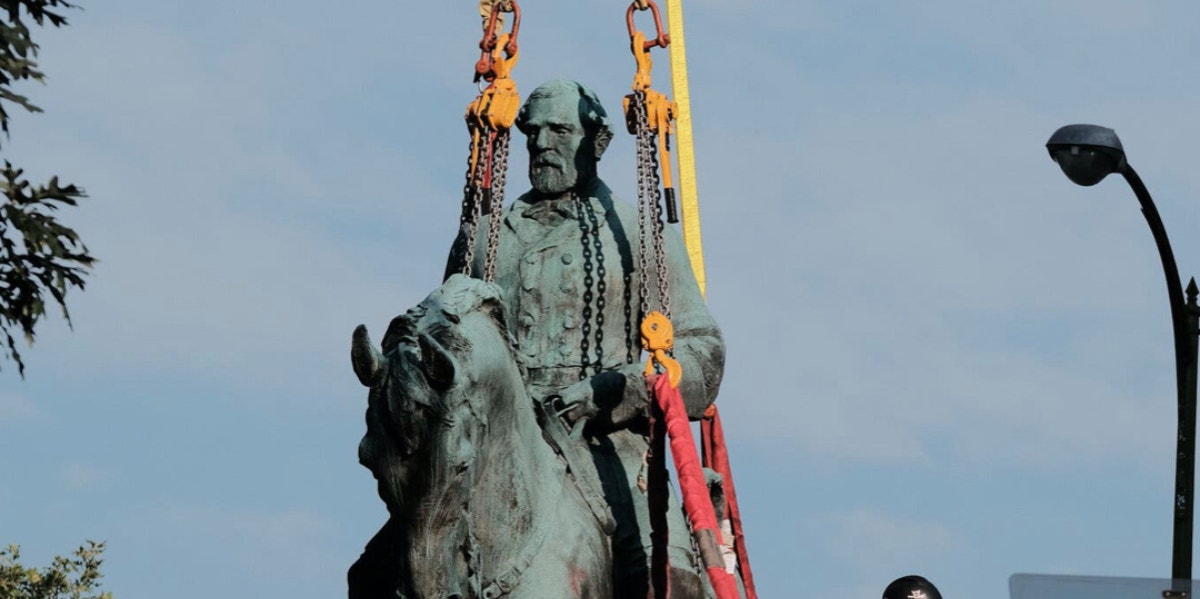Charlottesville's Robert E. Lee Statue Will Be Melted Down And Turned Into Public Art
A fitting end for the controversial statue.
 Twitter
Twitter The issue of confederate statues in public spaces has been a contentious one in recent years.
Many see such statues as places of pseudo-worship for groups like the supporters of the Lost Cause of the Confederacy. Others view the statues as important facets of the history of the United States, for better or worse, and that they should be allowed to remain where they are.
Others still see the statues as inappropriate, as they serve as uncontextualized glorifications of complicated historical figures that actively fought against the United States.
Charlottesville, Virginia is the latest battleground for this debate as the city has announced its Robert E. Lee statue will soon be removed.
Where will the Charolettesville Robert E. Lee statue be moved?
Around midnight on Tuesday the Charlottesville City Council voted unanimously to donate the city’s statue of the Confederate general Robert E. Lee to the Jefferson School African American Heritage Center.
The statue will come down and, in a fitting twist of fate, it will be handed over to a Black-led heritage group.
RELATED: An Open Letter To My White Friends — What I WISH You Knew About Charlottesville
The proposal for what the Jefferson School African American Heritage Center would do with the statue is part of their Swords Into Plowshares project.
The Swords Into Plowshares project seeks to take the statue of Lee and melt it down, then to take the bronze and allow the community of Charlottesville in conjunction with an artist to decide what to turn it into.
The final goal is that, “The artistic transformation will be informed by a six-month community engagement process where residents of Charlottesville can participate in forums to help determine how the social value of inclusion can be represented through art and public space.”
The Robert E. Lee statue in Charlottesville has been a much-debated issue.
The discussion and disagreement surrounding confederate statues is only a small piece of the larger discussion of race, inequality and systemic issues in the United States that has flared up in the past few years.
Charlottesville has been a hotbed of protest and even violence in the past few years, including beatings, marches and at least one death.
The preservation of the statues of confederate leaders in Charlottesville was one of the primary purposes of the Unite the Right rally that turned violent back in 2017.
This was the very rally that spawned images of swastikas and confederate flags being flown by white supremacists and massive marches lit by backyard tiki torches. This is also the rally where 32-year-old Heather Heyer was killed when a white supremacist drove his car into a crowd of counter-protesters.
RELATED: My Grandfather Killed Nazis In WWII — His Ghost Made Me Write This
It remains to be seen how this move by the Charlottesville City Council and the Jefferson School African American Heritage Center will be received. So far the people of Charlottesville and the council seem to be in agreement that this is the right decision.
In some ways, the Confederacy never fully died, even after its defeat at the hands of the Union in 1865. The ideologies of the short-lived rebellion live on today in white supremacist and far-right groups all over the United States.
The wounds inflicted on this country by slavery and the Civil War still have not fully healed.
On the topic of heritage and Confederate symbols, Robert E. Lee himself believed that it was a mistake for the United States to dwell on the war and the Confederate symbols saying, “I think it wiser not to keep open the sores of war but to follow the examples of those nations who endeavored to obliterate the marks of civil strife, to commit to oblivion the feelings engendered.”
Dan O'Reilly is a writer who covers news, politics, and social justice. Follow him on Twitter.

